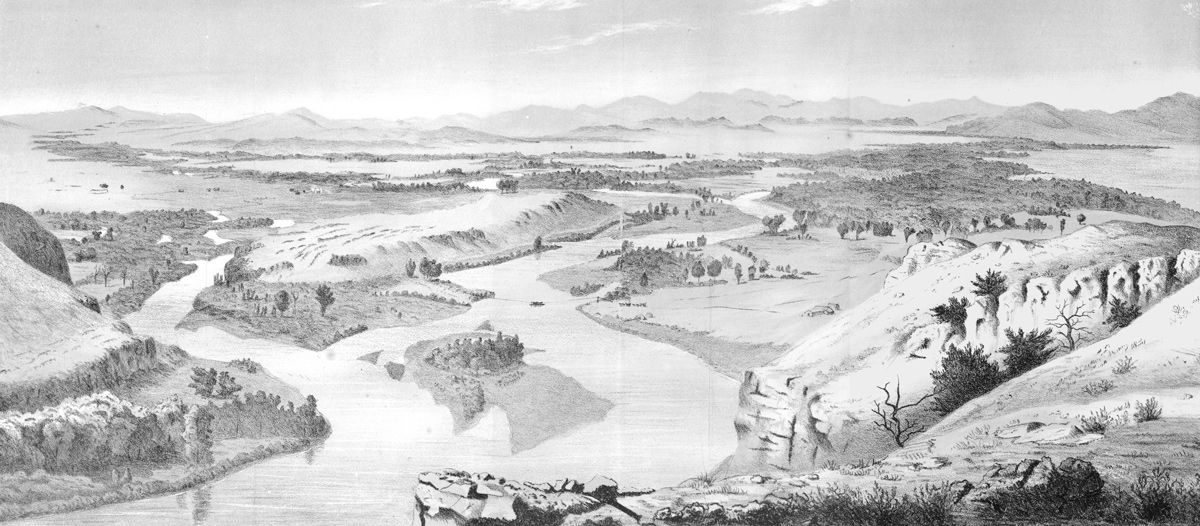Early in the day, Clark reaches the headwaters of the Missouri. He leaves a note for Lewis, who is behind with the main party with the dugouts. Lewis describes the speed of pronghorns, and Clark explores what they would later name the Jefferson River.
Clark at the Three Forks
by Yellowstone Public Radio[1]Originally aired weekdays by Yellowstone Public Radio during the Bicentennial observance of 2003-2006. Narrated by Hal Hansen. Scripts by Whit Hansen and Ed Jacobson. Produced by Leni Holliman. © … Continue reading
The Three Forks, 1868
Panoramic lithograph by Alfred E. Mathews (1831–1874)
Alfred E. Mathews, Pencil Sketches of Montana (1868).
The Three Forks of the Missouri
a fine morning we proceeded on a fiew miles to the three forks of the Missouri those three forks are nearly of a Size, the North fork appears to have the most water and must be Considered as the one best calculated for us to assend
—William Clark
Exploring the Jefferson River
I wrote a note informing Capt Lewis the rout I intended to take, and proeeded on up the main North fork thro’ a vallie . . . . emence number of beaver & orter maney thousand enhabit the river & Creeks near the 3 fork
—William Clark
The Pronghorn’s Fleetness
these anamals [pronghorns] appear now to have collected again is small herds several females with their young and one or two males compose the herd usually. if they happen accedentaly in the woodlands and are allarmed they run immediately to the plains, seeming to plaise a just confidence in their superior fleetness and bottom.
—Meriwether Lewis
Gass’s Creek
we passed a large Crk. today in the plain country, 25 yds. wide, which discharges itself on the Stard. side; it is composed of five streams which unite in the plain at no great distance from the river and have their souces in the Mts. this stream we called Gass’s Creek. after Sergt. Patric[k] Gass one of our party.—
—Meriwether Lewis
Double-manning the Boats
we found Several bad rockey rapids which we had to pass through and So Shallow the rocks Show themselves across the River and appear Shallow all the way across. we double manned and got up Safe.
—Joseph Whitehouse
Lombard Thrust Fault
Near Toston Dam, 23 July 2013. © Kristopher K. Townsend. Permission to use granted under the Creative Commons Attribution-Share Alike 4.0 International license.
I observed that the rocks which form the clifts on this part of the river appear as if they had been undermined by the river and by their weight had seperated from the parent hill and tumbled on their sides, the stratas of rock of which they are composed lying with their edges up; others not seperated seem obliquely depressed on the side next the river as if they had sunk down to fill the cavity which had been formed by the washing and wearing of the river.
—Meriwether Lewis
Weather Diary
State of the thermometer at rise
Weather at rise
Wind at rise
State of the Thermometer at 4 P.M. Weather at 4 P.M. Wind at 4 P.M. State of the river 60 [above 0] fair S. W. 86 [above 0] fair S. W. fallen ½ in. Snow appears on the mountains [the Tobacco Root Mountains] ahead.
—Meriwether Lewis[2]To assist the reader, the editor of this web page has omitted the date column, merged the “State of the river” columns, and spelled out some abbreviations.
Experience the Lewis and Clark Trail
The Lewis and Clark Trail Experience—our sister site at lewisandclark.travel—connects the world to people and places on the Lewis and Clark Trail.
Plan a trip related to July 25, 1805:

Three Forks of the Missouri is a High Potential Historic Site along the Lewis and Clark National Historic Trail managed by the U.S. National Park Service. The site a Montana State Park.
Notes
| ↑1 | Originally aired weekdays by Yellowstone Public Radio during the Bicentennial observance of 2003-2006. Narrated by Hal Hansen. Scripts by Whit Hansen and Ed Jacobson. Produced by Leni Holliman. © 2003 by Yellowstone Public Radio. |
|---|---|
| ↑2 | To assist the reader, the editor of this web page has omitted the date column, merged the “State of the river” columns, and spelled out some abbreviations. |




